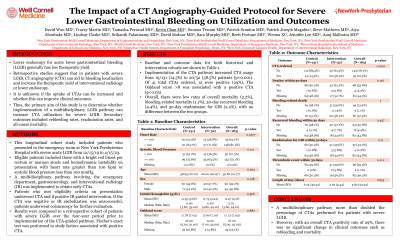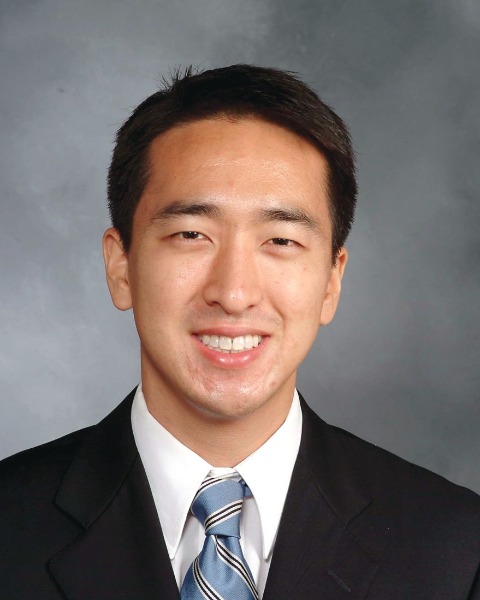Tuesday Poster Session
Category: GI Bleeding
P3451 - The Impact of a CT Angiography-Guided Protocol for Severe Lower Gastrointestinal Bleeding on Utilization and Outcomes
Tuesday, October 24, 2023
10:30 AM - 4:00 PM PT
Location: Exhibit Hall

Has Audio

David Wan, BS, MD
Weill Cornell Medicine
New York, NY
Presenting Author(s)
Award: ACG Governors Award for Excellence in Clinical Research
Award: Presidential Poster Award
David Wan, BS, MD1, Tracey Martin, MD2, Tamasha Persaud, MD1, Kevin Chan, MD3, Sunena Tewani, MD4, Patrick Scanlon, MD5, Patrick T.. Magahis, BA1, Steven N. Mathews, MD6, Aiya Aboubakr, MD7, Lindsay Clarke, MD8, Srikanth Palanisamy, MD9, David Bodnar, MD1, Sara Murphy, DO, MS10, Brett Fortune, MD, MS11, Wenna Xi, PhD1, Jennifer I. Lee, MD1, Anuj Malhotra, MD12
1Weill Cornell Medicine, New York, NY; 2SSM Health, St. Louis, MO; 3New York Presbyterian Weill Cornell, New York, NY; 4Rutgers Robert Wood Johnson Medical School, West Windsor, NJ; 5New York Presbyterian/Weill Cornell, New York, NY; 6New York-Presbyterian/Well Cornell Medicine, New York, NY; 7New York Presbyterian-Weill Cornell Medical Center, New York, NY; 8Brigham and Women's Hospital, Boston, MA; 9Stanford University, Palo Alto, CA; 10Mount Sinai, New York, NY; 11Montefiore Einstein, Bronx, NY; 12New York University Langone Health, New York, NY
Introduction: Lower endoscopy for acute lower gastrointestinal bleeding (LGIB) generally has low therapeutic yield. Retrospective studies suggest that in patients with severe LGIB, CT angiography (CTA) can aid in bleeding localization and increase the therapeutic yield of interventional radiology (IR) or lower endoscopy. It is unknown if the uptake of CTAs can be increased and whether this can improve clinical outcomes. Thus, the primary aim of this study is to determine whether implementation of a multidisciplinary LGIB pathway can increase CTA utilization for severe LGIB. Secondary outcomes included rebleeding rates, readmission rates, and all-cause mortality.
Methods: This longitudinal cohort study included patients who presented to the emergency room at New York Presbyterian Hospital with severe acute LGIB from 12/15/19 to 4/15/23. Eligible patients included those with bright red blood per rectum or maroon stools and hemodynamic instability on presentation with heart rate greater than 100 bpm or systolic blood pressure less than 100 mmHg. A multidisciplinary pathway involving the emergency department, gastroenterology, and IR was implemented to obtain early CTAs. Patients who met eligibility criteria on presentation underwent CTA and if positive IR guided intervention. If the CTA was negative or IR embolization was unsuccessful, patients underwent colonoscopy for further evaluation. Results were compared to a retrospective cohort of patients with severe LGIB over the four-year period prior to implementation of the CTA-guided pathway. Fischer’s exact test was performed to study factors associated with positive CTA.
Results: Baseline and outcome data for both historical and intervention cohorts are shown in Table 1. Implementation of the CTA pathway increased CTA usage from 19/131 (14.5%) to 20/52 (38.5%) patients (p< 0.001). Of 41 total CTAs recorded, 12 were positive (29%). The Oakland score < 8 or hemoglobin >10 g/dL was associated with a negative CTA (p< 0.02). Overall, there were low rates of 30-day all-cause mortality (2.2%), bleeding-related mortality (1.1%), 30-day recurrent bleeding (4.4%), and 30-day readmission for GIB (2.2%), with no difference between the two groups.
Discussion: A multidisciplinary pathway more than doubled the percentage of CTAs performed for patients with severe LGIB. However, with an overall CTA positivity rate of 29%, there was no significant change in clinical outcomes such as rebleeding and mortality.
Disclosures:
David Wan, BS, MD1, Tracey Martin, MD2, Tamasha Persaud, MD1, Kevin Chan, MD3, Sunena Tewani, MD4, Patrick Scanlon, MD5, Patrick T.. Magahis, BA1, Steven N. Mathews, MD6, Aiya Aboubakr, MD7, Lindsay Clarke, MD8, Srikanth Palanisamy, MD9, David Bodnar, MD1, Sara Murphy, DO, MS10, Brett Fortune, MD, MS11, Wenna Xi, PhD1, Jennifer I. Lee, MD1, Anuj Malhotra, MD12. P3451 - The Impact of a CT Angiography-Guided Protocol for Severe Lower Gastrointestinal Bleeding on Utilization and Outcomes, ACG 2023 Annual Scientific Meeting Abstracts. Vancouver, BC, Canada: American College of Gastroenterology.
Award: Presidential Poster Award
David Wan, BS, MD1, Tracey Martin, MD2, Tamasha Persaud, MD1, Kevin Chan, MD3, Sunena Tewani, MD4, Patrick Scanlon, MD5, Patrick T.. Magahis, BA1, Steven N. Mathews, MD6, Aiya Aboubakr, MD7, Lindsay Clarke, MD8, Srikanth Palanisamy, MD9, David Bodnar, MD1, Sara Murphy, DO, MS10, Brett Fortune, MD, MS11, Wenna Xi, PhD1, Jennifer I. Lee, MD1, Anuj Malhotra, MD12
1Weill Cornell Medicine, New York, NY; 2SSM Health, St. Louis, MO; 3New York Presbyterian Weill Cornell, New York, NY; 4Rutgers Robert Wood Johnson Medical School, West Windsor, NJ; 5New York Presbyterian/Weill Cornell, New York, NY; 6New York-Presbyterian/Well Cornell Medicine, New York, NY; 7New York Presbyterian-Weill Cornell Medical Center, New York, NY; 8Brigham and Women's Hospital, Boston, MA; 9Stanford University, Palo Alto, CA; 10Mount Sinai, New York, NY; 11Montefiore Einstein, Bronx, NY; 12New York University Langone Health, New York, NY
Introduction: Lower endoscopy for acute lower gastrointestinal bleeding (LGIB) generally has low therapeutic yield. Retrospective studies suggest that in patients with severe LGIB, CT angiography (CTA) can aid in bleeding localization and increase the therapeutic yield of interventional radiology (IR) or lower endoscopy. It is unknown if the uptake of CTAs can be increased and whether this can improve clinical outcomes. Thus, the primary aim of this study is to determine whether implementation of a multidisciplinary LGIB pathway can increase CTA utilization for severe LGIB. Secondary outcomes included rebleeding rates, readmission rates, and all-cause mortality.
Methods: This longitudinal cohort study included patients who presented to the emergency room at New York Presbyterian Hospital with severe acute LGIB from 12/15/19 to 4/15/23. Eligible patients included those with bright red blood per rectum or maroon stools and hemodynamic instability on presentation with heart rate greater than 100 bpm or systolic blood pressure less than 100 mmHg. A multidisciplinary pathway involving the emergency department, gastroenterology, and IR was implemented to obtain early CTAs. Patients who met eligibility criteria on presentation underwent CTA and if positive IR guided intervention. If the CTA was negative or IR embolization was unsuccessful, patients underwent colonoscopy for further evaluation. Results were compared to a retrospective cohort of patients with severe LGIB over the four-year period prior to implementation of the CTA-guided pathway. Fischer’s exact test was performed to study factors associated with positive CTA.
Results: Baseline and outcome data for both historical and intervention cohorts are shown in Table 1. Implementation of the CTA pathway increased CTA usage from 19/131 (14.5%) to 20/52 (38.5%) patients (p< 0.001). Of 41 total CTAs recorded, 12 were positive (29%). The Oakland score < 8 or hemoglobin >10 g/dL was associated with a negative CTA (p< 0.02). Overall, there were low rates of 30-day all-cause mortality (2.2%), bleeding-related mortality (1.1%), 30-day recurrent bleeding (4.4%), and 30-day readmission for GIB (2.2%), with no difference between the two groups.
Discussion: A multidisciplinary pathway more than doubled the percentage of CTAs performed for patients with severe LGIB. However, with an overall CTA positivity rate of 29%, there was no significant change in clinical outcomes such as rebleeding and mortality.
Disclosures:
David Wan indicated no relevant financial relationships.
Tracey Martin indicated no relevant financial relationships.
Tamasha Persaud indicated no relevant financial relationships.
Kevin Chan indicated no relevant financial relationships.
Sunena Tewani indicated no relevant financial relationships.
Patrick Scanlon indicated no relevant financial relationships.
Patrick Magahis indicated no relevant financial relationships.
Steven Mathews indicated no relevant financial relationships.
Aiya Aboubakr indicated no relevant financial relationships.
Lindsay Clarke indicated no relevant financial relationships.
Srikanth Palanisamy indicated no relevant financial relationships.
David Bodnar indicated no relevant financial relationships.
Sara Murphy indicated no relevant financial relationships.
Brett Fortune: W L Gore and Associates – Consultant.
Wenna Xi indicated no relevant financial relationships.
Jennifer Lee indicated no relevant financial relationships.
Anuj Malhotra indicated no relevant financial relationships.
David Wan, BS, MD1, Tracey Martin, MD2, Tamasha Persaud, MD1, Kevin Chan, MD3, Sunena Tewani, MD4, Patrick Scanlon, MD5, Patrick T.. Magahis, BA1, Steven N. Mathews, MD6, Aiya Aboubakr, MD7, Lindsay Clarke, MD8, Srikanth Palanisamy, MD9, David Bodnar, MD1, Sara Murphy, DO, MS10, Brett Fortune, MD, MS11, Wenna Xi, PhD1, Jennifer I. Lee, MD1, Anuj Malhotra, MD12. P3451 - The Impact of a CT Angiography-Guided Protocol for Severe Lower Gastrointestinal Bleeding on Utilization and Outcomes, ACG 2023 Annual Scientific Meeting Abstracts. Vancouver, BC, Canada: American College of Gastroenterology.

